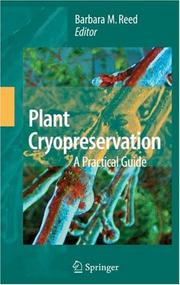| Listing 1 - 10 of 17 | << page >> |
Sort by
|
Book
ISBN: 0470267860 Year: 1979 Publisher: New York
Abstract | Keywords | Export | Availability | Bookmark
 Loading...
Loading...Choose an application
- Reference Manager
- EndNote
- RefWorks (Direct export to RefWorks)

ISBN: 0786401702 Year: 1996 Publisher: Jefferson (N.C.) : McFarland,
Abstract | Keywords | Export | Availability | Bookmark
 Loading...
Loading...Choose an application
- Reference Manager
- EndNote
- RefWorks (Direct export to RefWorks)
Cryonics. --- Dead --- Dead --- Donation of organs, tissues, etc. --- Funeral rites and ceremonies. --- History. --- Social aspects.
Book
ISBN: 1838802061 1838802053 Year: 2020 Publisher: London, England : IntechOpen,
Abstract | Keywords | Export | Availability | Bookmark
 Loading...
Loading...Choose an application
- Reference Manager
- EndNote
- RefWorks (Direct export to RefWorks)
Book
ISBN: 9535143263 9535103024 Year: 2012 Publisher: IntechOpen
Abstract | Keywords | Export | Availability | Bookmark
 Loading...
Loading...Choose an application
- Reference Manager
- EndNote
- RefWorks (Direct export to RefWorks)
Almost a decade has passed since the last textbook on the science of cryobiology, Life in the Frozen State, was published. Recently, there have been some serious tectonic shifts in cryobiology which were perhaps not seen on the surface but will have a profound effect on both the future of cryobiology and the development of new cryopreservation methods. We feel that it is time to revise the previous paradigms and dogmas, discuss the conceptually new cryobiological ideas, and introduce the recently emerged practical protocols for cryopreservation. The present books, ""Current Frontiers in Cryobiology"" and ""Current Frontiers in Cryopreservation"" will serve the purpose. This is a global effort by scientists from 27 countries from all continents and we hope it will be interesting to a wide audience.
Cryopreservation of organs, tissues, etc. --- Cryoconservation of organs, tissues, etc. --- Cryogenic preservation of organs, tissues, etc. --- Low temperature preservation of organs, tissues, etc. --- Preservation of organs, tissues, etc. --- Cryobiology --- Cryonics --- Life Sciences --- Plant Biology --- Agricultural and Biological Sciences
Book
ISBN: 1626184755 9781626184756 9781626184749 1626184747 Year: 2013 Publisher: New York
Abstract | Keywords | Export | Availability | Bookmark
 Loading...
Loading...Choose an application
- Reference Manager
- EndNote
- RefWorks (Direct export to RefWorks)
Cultures (Biology) --- Cryopreservation of organs, tissues, etc. --- Plant cells and tissues --- Cryoconservation of organs, tissues, etc. --- Cryogenic preservation of organs, tissues, etc. --- Low temperature preservation of organs, tissues, etc. --- Preservation of organs, tissues, etc. --- Cryobiology --- Cryonics --- Cryopreservation.
Book
ISBN: 9783748933465 Year: 2022 Publisher: Baden-Baden : Nomos,
Abstract | Keywords | Export | Availability | Bookmark
 Loading...
Loading...Choose an application
- Reference Manager
- EndNote
- RefWorks (Direct export to RefWorks)
"Die Kryokonservierung unbefruchteter Eizellen stellt eine relativ neuartige Technologie zum Erhalt weiblichen Fertilität dar. Immer öfter wird dieses Verfahren dabei auch ohne Vorliegen einer medizinischen Indikation in Anspruch genommen ("Social Egg Freezing"). Der Autor unterzieht - aufbauend auf einer empirischen und rechtlichen Analyse - diese nicht unumstrittene Technik einer ethischen Analyse. Ein spezieller Fokus wird dabei auf die Frage gelegt, in welchem Verhältnis Social Egg Freezing zur philosophischen Frage nach dem guten Leben steht. Hierbei wird das Argument entwickelt, dass ein ernstzunehmendes Gefahrenmoment dieser Technik gerade darin liegt, existentielle Lebensentscheidungen immer weiter aufzuschieben"--
Book
ISBN: 9535127802 9535127799 9535141430 Year: 2016 Publisher: IntechOpen
Abstract | Keywords | Export | Availability | Bookmark
 Loading...
Loading...Choose an application
- Reference Manager
- EndNote
- RefWorks (Direct export to RefWorks)
Since accidentally discovering the ability of glycerol on protecting cells from freezing damage, many researchers have been pursuing to develop cryopreservation methods of a very wide range of cells and some tissues, and these have found widespread applications in biology and medicine. From the point of view of living organisms, cryopreservation is a useful tool for ex situ conservation of genetic resources together with its contribution on conservation of their biodiversity. Cryopreservation in Eukaryotes includes totally 12 chapters, which have been written by the expert researchers in the field. The chapters are a comprehensive collection of the most frequently used methods for eukaryotes. With this book, every researcher will better understand the principles, background, and current status of cryopreservation in particular organisms.
Cryopreservation of organs, tissues, etc. --- Eukaryotic cells. --- Methodology. --- Eucaryotic cells --- Cells --- Protista --- Cryoconservation of organs, tissues, etc. --- Cryogenic preservation of organs, tissues, etc. --- Low temperature preservation of organs, tissues, etc. --- Preservation of organs, tissues, etc. --- Cryobiology --- Cryonics --- Life Sciences --- Microbiology --- Genetics and Molecular Biology --- Cytology --- Biochemistry
Book
ISBN: 3319785982 3319785990 Year: 2018 Publisher: Cham : Springer International Publishing : Imprint: Palgrave Pivot,
Abstract | Keywords | Export | Availability | Bookmark
 Loading...
Loading...Choose an application
- Reference Manager
- EndNote
- RefWorks (Direct export to RefWorks)
Cryonics—also known as cryopreservation or cryosuspension—is the preservation of legally dead individuals at ultra-low temperatures. Those who undergo this procedure hope that future technology will not only succeed in reviving them, but also cure them of the condition that led to their demise. In this sense, some hope that cryopreservation will allow people to continue living indefinitely. This book discusses the moral concerns of cryonics, both as a medical procedure and as an intermediate step toward life extension. In particular, Minerva analyses the moral issues surrounding cryonics-related techniques (including the hypothetical cryosuspension of fetuses as an alternative to abortion) by focusing on how they might impact the individuals who undergo cryosuspension, as well as society at large. .
Cryonics. --- Cryogenic interment --- Freezing of human bodies --- Human cold storage --- Burial --- Cryopreservation of organs, tissues, etc. --- Immortalism --- Resuscitation --- Technology—Sociological aspects. --- Bioethics. --- Physical anthropology. --- Science and Technology Studies. --- Biological and Physical Anthropology. --- Biological anthropology --- Somatology --- Anthropology --- Human biology --- Biology --- Biomedical ethics --- Life sciences --- Life sciences ethics --- Science --- Moral and ethical aspects
Book
ISBN: 026233870X 9780262338691 0262338696 9780262338707 9780262035859 0262035855 Year: 2017 Publisher: Cambridge, Massachusetts : The MIT Press,
Abstract | Keywords | Export | Availability | Bookmark
 Loading...
Loading...Choose an application
- Reference Manager
- EndNote
- RefWorks (Direct export to RefWorks)
The social, political, and cultural consequences of attempts to cheat death by freezing life.
Cryopreservation of organs, tissues, etc. --- Death --- Methods. --- Political aspects. --- Psychological aspects. --- SCIENCE, TECHNOLOGY & SOCIETY/General --- Cryoconservation of organs, tissues, etc. --- Cryogenic preservation of organs, tissues, etc. --- Low temperature preservation of organs, tissues, etc. --- Preservation of organs, tissues, etc. --- Cryobiology --- Cryonics --- Psychology

ISBN: 1281108286 9786611108281 0387722769 0387722750 1441924728 Year: 2008 Publisher: New York : Springer,
Abstract | Keywords | Export | Availability | Bookmark
 Loading...
Loading...Choose an application
- Reference Manager
- EndNote
- RefWorks (Direct export to RefWorks)
Plant Cryopreservation: A Practical Guide is a unique resource for plant scientists in many fields. This compilation provides over 100 ready-to-use protocols for plant types from algae and bryophytes to a range of flowering plants. It includes techniques for diverse plant parts such as dormant buds, pollen, and apical meristems, and for cell types such as suspension and callus cultures. Five introductory chapters describe theoretical principles, practical aspects of long-term cryopreserved storage, and details of the main cryopreservation techniques. The remaining 14 chapters are separated by plant type. Each chapter briefly reviews the literature and includes ready-to-use protocols designed for easy transfer into the lab and adaptation to new species.
Plant cells and tissues --- Germplasm resources, Plant --- Cryopreservation of organs, tissues, etc. --- Cryopreservation. --- Cryoconservation of organs, tissues, etc. --- Cryogenic preservation of organs, tissues, etc. --- Low temperature preservation of organs, tissues, etc. --- Preservation of organs, tissues, etc. --- Cryobiology --- Cryonics --- Agriculture. --- Plant genetics. --- Botany. --- Plant Genetics and Genomics. --- Plant Sciences. --- Botanical science --- Phytobiology --- Phytography --- Phytology --- Plant biology --- Plant science --- Biology --- Natural history --- Plants --- Genetics --- Farming --- Husbandry --- Industrial arts --- Life sciences --- Food supply --- Land use, Rural --- Plant science. --- Floristic botany
| Listing 1 - 10 of 17 | << page >> |
Sort by
|

 Search
Search Feedback
Feedback About UniCat
About UniCat  Help
Help News
News